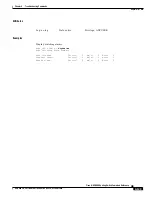
9-131
Cisco MGX 8850 Routing Switch Command Reference
Release 2.0, Part Number 78-10467-04 Rev C0, October 2001
Chapter 9
Troubleshooting Commands
dspxbar
dspxbar
Display Crossbar—display the configuration of the crossbars
The dspxbar command displays general information about the configuration of a switch plane (or
switching fabric or crossbar, also synonymous with switch ASIC). The configuration normally has fixed
default values and is not configurable.
Note
The low-level dspxbar command normally applies to software or hardware development and
therefore is not useful for troubleshooting at the network or node level. Normally, to isolate a
switching problem to determine whether to return a card, the dspswalm command is sufficient.
The crossbar-related commands are special debug commands with infrequent use. An engineer that
needs to alter certain error thresholds for hardware or software development can use the
cnfxbarerrthresh commands.
Connectivity Between the Switching Fabric and Card Slots
Before attempting to interpret the contents of the dspxbar output, some perspective on the crossbar
information is appropriate. The focus of the crossbar commands is from the switch ASICs outwards, to
the card slots. The reference point in relation to card slots is important and has to do with the wiring of
the backplane. The connectivity between the cards and the switch fabric—consisting of all the switch
ASICs in total—forms a mesh: each switch ASIC communicates with each card, and each card can use
any ASIC. Therefore, if one ASIC becomes inoperative, the switching fabric continues to support new
or existing connections within the switch, but the throughput falls far short of the maximum. Of less
drastic effect would be a condition where one backplane trace can no longer carry data between an
individual ASIC pin and a particular card slot. The dspxbarerrcnt command can help isolate such
faults. Regardless, at the node level, the dspswalms command is sufficient for determining whether to
replace the card with switching problem.
The Contents of the dspxbar Output
Refer to the examples to see the location of each of the following fields. The general information that
dspxbar displays is the:
•
Selected ASIC number (default 0 is unspecified).
•
Number of the slot where the crossbar ASIC resides (7 or 8 for an MGX 8850 node).
•
Number of the ASIC (0–2 in an MGX 8850 node).
•
Revision number of the ASIC.
•
Status of the ASIC.The status is either failed or OK. If the status is failed, the other ASICs must
carry the switching load, and the throughput of the switch falls below the maximum. In this case,
Cisco Systems recommends you replace the card.
•
The cell grant mode is always Multicast Preferred.
•
The Resync Sframe Tic is the rising edge of the clock. Sframe refers to a switch frame. (A switch
frame is a 60-byte cell that carries a 53-byte ATM cell plus a special header for internal fabric use
between the switching fabric and the service module.
















































